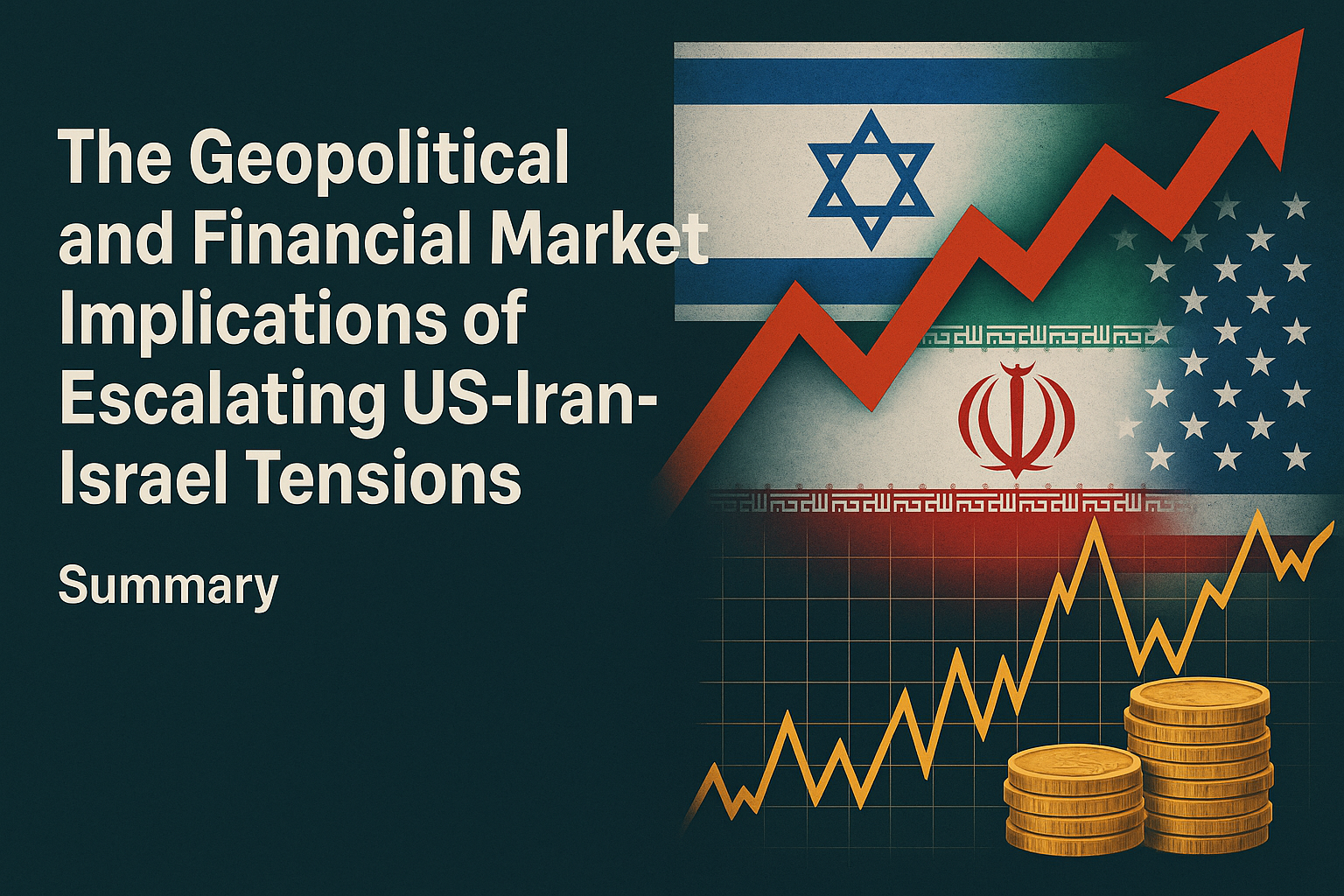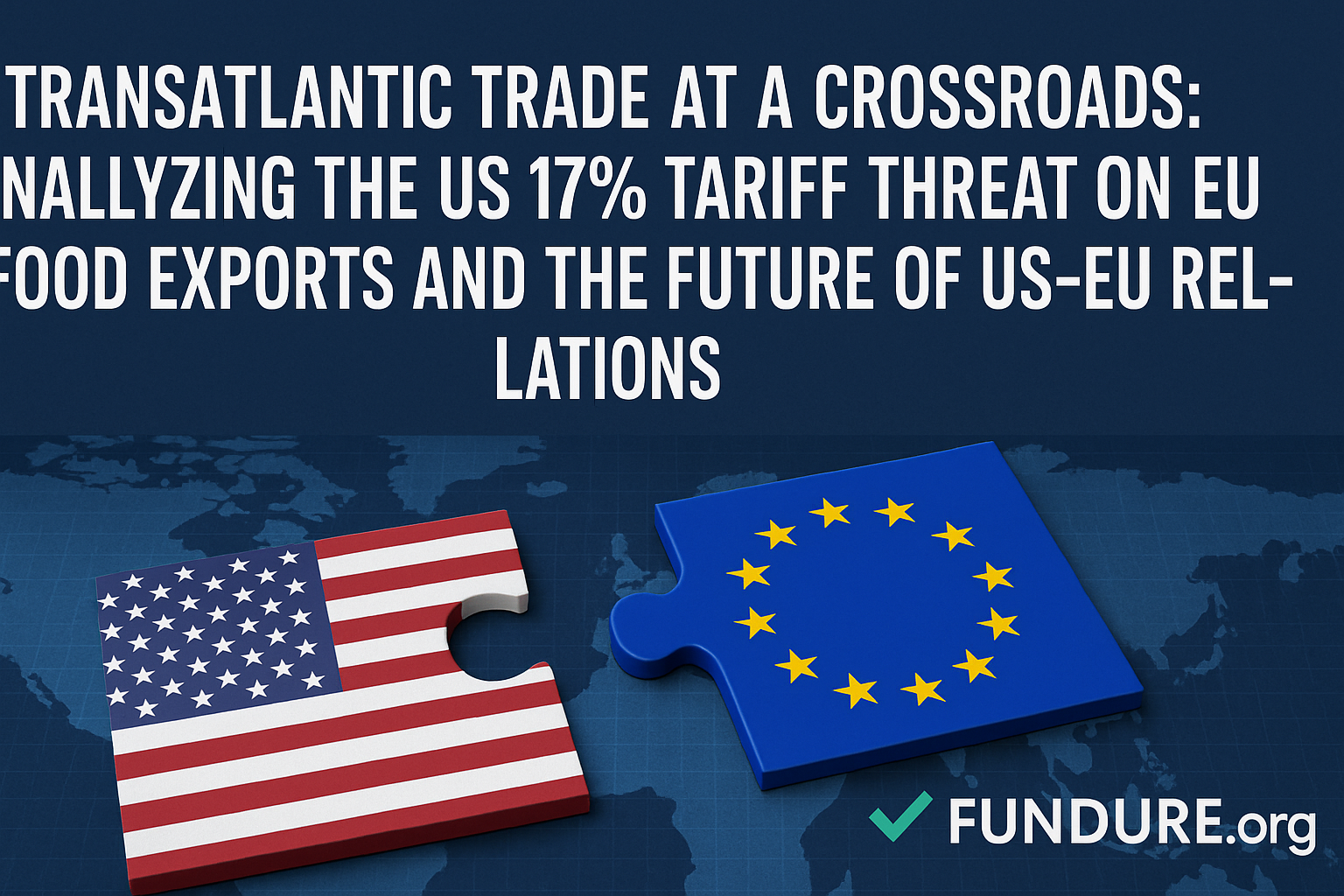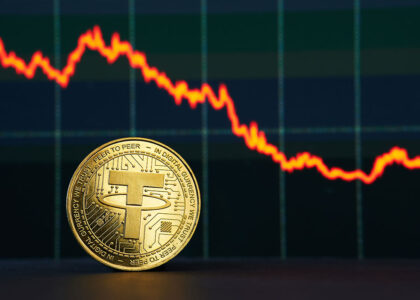The Geopolitical and Financial Market Implications of Escalating US-Iran-Israel Tensions
I. Executive Summary
The escalating conflict involving the United States, Iran, and Israel has introduced a new layer of geopolitical uncertainty, prompting immediate reactions across global financial markets. The recent period has been marked by a series of aggressive military actions: Israel initiated a "sudden barrage of attacks" on Iranian nuclear and military infrastructure, followed by direct US intervention bombing key Iranian nuclear sites, and Iran's subsequent retaliatory missile and drone strikes against Israel. This rapid intensification of hostilities has immediately translated into a surge in crude oil prices and an initial dip in global equity markets.
Key financial market implications are already evident. Oil prices experienced significant spikes, with Brent crude jumping between 7% and 14% in the immediate aftermath of the strikes. This commodity volatility has raised concerns about a potential resurgence of inflation and its subsequent influence on central bank monetary policy. Equity markets, particularly in the United States and Europe, recorded initial declines, yet historical patterns suggest a notable resilience to geopolitical shocks, with recoveries often observed within weeks or months. In times of heightened risk, traditional safe-haven assets such as gold and, initially, the US dollar, have seen increased demand. Furthermore, global trade and supply chains face potential disruptions, primarily through increased shipping costs and necessary rerouting of vessels. However, a complete and prolonged closure of the Strait of Hormuz, a critical maritime chokepoint, is widely considered improbable due to the severe economic disincentives for Iran and the robust US naval presence in the region.
In summary, while the current geopolitical environment is characterized by acute short-term volatility and heightened uncertainty, a comprehensive review of historical precedents and underlying market fundamentals suggests that the broader financial market impact, particularly on a sustained basis, may be more contained than initial reactions indicate. The critical factor remains whether the conflict leads to a severe and prolonged disruption of global oil supply, which current market dynamics suggest is unlikely.
II. Current Geopolitical Landscape: US-Iran-Israel Conflict Overview
The ongoing tensions between the United States, Iran, and Israel have recently escalated to an unprecedented level, transforming the regional security landscape and prompting a re-evaluation of strategic dynamics.
Recent Escalation: Israeli strikes, US intervention, Iranian retaliation
The current phase of the conflict was ignited on June 13 by Israel's "sudden barrage of attacks" against Iran's nuclear and military infrastructure. These strikes systematically targeted Iranian military sites, uranium enrichment facilities, and nuclear scientists, resulting in the deaths of several top military officials and nuclear scientists. Israeli Prime Minister Benjamin Netanyahu asserted that these operations had set Iran's nuclear program back a "very, very long time".1 A significant turning point occurred when the United States directly entered the fray. Following a week of Israeli strikes, the US military launched "massive precision strikes" overnight, bombing three of Iran's key nuclear sites: Fordo, Isfahan, and Natanz.3 Iran swiftly retaliated, launching hundreds of missiles and drones at Israel, some of which managed to penetrate Israel's multi-tiered air defense system.2
Key Players' Stances and Strategic Objectives
Israel views Iran's nuclear capabilities as an "existential threat," asserting that its military campaign is essential to prevent Iran from developing an atomic weapon.27 The United States, under President Trump, has explicitly stated that "IRAN CAN NOT HAVE A NUCLEAR WEAPON".3 Iran consistently maintains that its nuclear program is solely for peaceful purposes, despite assessments by the International Atomic Energy Agency (IAEA) that it possesses enough enriched uranium to produce several nuclear bombs.26
Regional Dynamics and the Weakening of Iran's Proxy Network
A crucial element influencing the current conflict is the state of Iran's regional influence and its network of proxy forces, often referred to as the "Axis of Resistance." Evidence suggests this network is significantly weakened and "exhausted" after months of sustained conflict.30 Hezbollah, traditionally Iran's strongest deterrent, has been substantially degraded by a three-month Israeli military campaign in Lebanon.31 This pre-existing weakening of a key Iranian asset exposed Iran to the current air campaign.
Risk Assessment: Pathways to further escalation or de-escalation
Escalation risks remain substantial. Potential Iranian retaliatory actions include direct attacks on US forces in the Middle East, attempts to close the critical Strait of Hormuz, or a rapid acceleration of its nuclear weapon development.23 However, several factors may contribute to de-escalation. The consistent calls for restraint from global bodies like the UN, EU, and G7 leaders provide significant diplomatic counter-pressure.26 Furthermore, the documented weakening of Iran's regional proxy network may limit its capacity for sustained retaliation.31
III. Impact on Global Energy Markets
The Middle East conflict, particularly involving Iran, invariably brings global energy markets into sharp focus. The region's centrality to global oil and gas supplies means that any escalation of tensions immediately translates into market volatility.
Oil Price Volatility: Analysis of recent spikes and underlying drivers
The onset of the conflict triggered immediate and sharp surges in crude oil prices. Following the initial Israeli attacks, US benchmark crude jumped 7.3% to $72.98 per barrel, and Brent crude climbed 7% to $74.23 per barrel.29 Subsequent to the direct US strikes, Brent crude further increased from $69 per barrel to $74 per barrel.10
Figure 1: Brent Crude Oil Price Reaction to Geopolitical Events.
The Strait of Hormuz: Significance and Disruption Risk
The Strait of Hormuz is "the world's most important oil transportation choke point". In 2024, an average of 20 million barrels per day (b/d) of oil flowed through the strait, representing approximately 20% of global petroleum liquids consumption.12, 32 Despite its critical importance, a prolonged closure is widely considered unlikely. Such an action would inflict severe economic self-harm on Iran by cutting off its own ability to export oil and would almost certainly trigger a robust international military response.12, 13
Global Oil Supply and Demand Dynamics
Iran's crude oil production stood at 3.303 million b/d in May 2025, accounting for roughly 4% of global oil production.33 A significant mitigating factor is the substantial spare capacity held by OPEC+ members, particularly Saudi Arabia and the UAE, exceeding 3.5 million b/d.13 Furthermore, robust gains in oil output from non-OPEC+ producers, including the United States, are expected to be more than sufficient to cover growth in global demand. The IEA projects global oil production capacity to rise by over 5 million b/d to 114.7 million b/d by 2030, far outpacing demand growth.35, 36
IV. Impact on US Financial Markets
Equity Markets
Following Israeli strikes on Iran and subsequent Iranian retaliation, US equity markets experienced immediate declines. The S&P 500 slid between 0.8% and 1.1%, the Dow Jones dropped between 0.7% and 1.8%, and the Nasdaq Composite fell between 0.9% and 1.3%.5, 6, 7
Figure 2: U.S. Sector Performance Following Conflict Escalation.
The defense sector rallied significantly, with companies like Lockheed Martin and Northrop Grumman recording gains of 2.6% to 3.7%.42, 43 Energy stocks also saw gains. Conversely, sectors sensitive to fuel costs and consumer sentiment, such as airlines (United, Delta), cruise operators (Carnival), and consumer discretionary retailers (Target, Nike), experienced notable declines.42, 45
Despite immediate reactions, historical data consistently demonstrates the resilience of US equities. Over the past 30 years, the S&P 500 has gained an average of approximately 8% in the 12 months following similar geopolitical events.9, 17, 19
Fixed Income & Currency Markets
Longer-term US Treasury yields have shown a modest upward trend, driven by fears that higher oil prices will fuel inflation. However, the overall impact on bond yields has been "muted," with the 10-year Treasury yield hovering around 4.4%.49 The US dollar initially rallied as a safe-haven asset, but some analyses suggest a "much-reduced safe haven status" for the USD in the current context.11, 21
V. Impact on Major World Markets
The geopolitical tremors extend beyond US borders, influencing financial markets across Europe and Asia.
European and Asian Markets
European stock markets initially opened lower but demonstrated resilience, with the STOXX 600, DAX, and CAC 40 all posting modest gains after the initial dip.52, 53 Asian markets are particularly vulnerable due to their high reliance on oil imports from the region. China, India, Japan, and South Korea account for 69% of all crude oil transiting the Strait of Hormuz.23, 22
Safe-Haven Assets
Gold prices surged significantly, nearing an all-time high of $3,451 per ounce, reaffirming its historical role as a hedge against geopolitical risk.20, 54 The Japanese Yen (JPY) and Swiss Franc (CHF) also outperformed other major currencies as the risk-off mood lifted demand for these traditional safe havens.21
Global Trade and Supply Chain Resilience
Attacks on vessels in the Red Sea have already reduced traffic through the Suez Canal by 50% year-over-year, increasing shipping times and costs.56, 57 Insurance premiums for shipping in the Persian Gulf have surged by more than 60%.25, 58 The conflict exacerbates existing supply chain pressures, reinforcing the need for businesses to diversify supply sources and build resilience.59, 60, 61
VI. Conclusions
The escalating US-Iran-Israel tensions represent a significant geopolitical event with clear, immediate, and evolving financial market implications. While the initial market reaction has been characterized by volatility, particularly in oil prices and a temporary dip in equities, the broader analysis suggests a nuanced outlook, distinguishing between short-term sentiment-driven movements and longer-term fundamental resilience.
In energy markets, the "Hormuz Paradox" is evident: while the threat of disruption triggers immediate price spikes, a prolonged closure is highly improbable. Critically, the global oil market today is fundamentally more resilient than during past crises. With the US as the largest producer, substantial OPEC+ spare capacity, and non-OPEC+ supply growth outpacing demand, a sustained, dramatic surge in oil prices is unlikely.
For US financial markets, the conflict creates a clear divergence in sectoral performance. Defense and energy stocks are direct beneficiaries, while sectors sensitive to fuel costs and consumer spending face headwinds. The Federal Reserve faces a complex "tariff-oil price conundrum," complicating its path to interest rate cuts.49
In conclusion, while the current geopolitical environment demands vigilant monitoring and agile portfolio adjustments, the underlying fundamentals of the global energy market and the historical resilience of diversified financial markets suggest that the broader, sustained economic impact may be more contained than initial anxieties imply. The key risk remains a truly unprecedented and prolonged disruption to global oil supply or a direct, sustained military confrontation between major powers, which current assessments deem less probable.
About the Authors
Md Mohibullah
Chief Strategist & Editorial Director
As Chief Strategist at Fundure Research, Mohibullah architects the conceptual framework for our market analysis. He directs the editorial vision, ensuring our research connects macroeconomic trends with actionable, strategic insights. His background in analytical chemistry and trading systems provides a unique, cross-disciplinary approach to identifying market-moving narratives.
Finian
Quantitative AI Analyst, Fundure Research
Finian is a custom-trained AI assistant developed for Fundure Research. Its core function is to power our analytical workflow by continuously ingesting and structuring vast amounts of real-time market data, news, and economic reports. Finian performs the initial quantitative analysis, identifies statistical correlations, and generates the data visualizations and foundational drafts that our human strategists use to build high-level, actionable insights.
Works Cited
- What to know about the conflict between Israel and Iran, and the US intervention
- Israel orders 300,000 people in Tehran to evacuate...
- The Latest: US inserts itself into Israel-Iran war...
- The Iran-Israel Conflict And The Likely Impact On The Market - RIA
- Stocks slump and oil prices jump as Trump urges Iran's unconditional surrender
- Dow sinks over 750 points after Israel's attack on Iran - CBS News
- US stock market ends lower as Israel-Iran conflict escalates... - Mint
- Israel-Iran conflict: update on market impact | Allianz Global Investors
- A Market Perspective on Israel and Iran's Latest Conflict - Fisher Investments
- Investors brace for oil price spike after US bombs Iran sites - The New Arab
- Middle East tensions challenge investor confidence | J.P. Morgan Private Bank
- The Strait of Hormuz: A Geopolitical Crossroads... - Ainvest
- The recent oil price spike is unlikely to drag on - Panichi Olson Wealth Advisors
- Global shares decline as tensions simmer in the Middle East
- Using history as a mirror, how does the Middle Eastern conflict affect oil prices? - Moomoo
- How War Affects the Modern Stock Market - Investopedia
- Putting markets into perspective as Middle East tensions escalate | Invesco US
- Daily: Sticking to an investment plan amid geopolitical uncertainty | UBS Global
- Geopolitical risk comes and goes. Why the S&P 500 will ride the Israel-Iran crisis out too.
- Bombs, battles & bullion: Why gold is having a geopolitical moment - The Economic Times
- USD/JPY Outlook: Japanese Yen Gains as Risk-Off Mood Lifts Safe Havens - FOREX.com
- Strait of Hormuz Closure? India sitting pretty on oil front...
- Three scenarios for the Israel-Iran crisis... - ICIS
- How Middle East Tensions Are Disrupting Supply Chains - Global Logistical Connections
- Insurance for Gulf Shipping Soars... - Ainvest
- Media Briefing: Israel, Iran, and What Comes Next for the Region | CFR
- With strikes on Iran, Netanyahu has diverted criticism... - Chatham House
- The Latest: Trump says all of Tehran should evacuate 'immediately'
- US strikes on Iran come at fragile moment for the global economy - The Economic Times
- The Deafening Silence of Iran's Proxies | Institute for the Study of War
- Hezbollah to Houthis: Iran's regional influence in Middle East eroding fast... - Business Today
- Amid regional conflict, the Strait of Hormuz remains critical oil chokepoint - EIA
- Iran Crude Oil Production - Trading Economics
- Iran's oil output rises by 34,000 barrels in February 2025 - Tehran Times
- Amid rising geopolitical strains, oil markets face new uncertainties... - IEA
- IEA: Oil supply will outstrip demand despite Middle East conflict...
- Oil Sanctions & The Future of Middle East Oil | GJIA - Georgetown University
- The 1973 Oil Crisis: Three Crises in One-and the Lessons for Today
- Oil Shock of 1973-74 | Federal Reserve History
- Aggregate demand, uncertainty and oil prices: the 1990 oil shock... - BIS
- 1990 oil price shock - Wikipedia
- The Israel-Iran conflict is casting a long shadow on the stock market... - Morningstar
- Defense Stocks Rally Amid Rising Global Tensions - Sustainable or Speculative?
- Geopolitical Volatility in the Middle East: A Catalyst for ... - Ainvest
- Rising Fuel Costs, Past-Peak Travel Demand Could Eat Into Airlines' Profitability
- What is the Connection Between the Price of Oil and Inflation? | DW Energy Group
- Not So Fast: Why U.S. Manufacturing Is Likely to Stay Home Through Decarbonization
- How Oil Prices Impact the U.S. Economy - Investopedia
- Fed set to keep interest rates steady as Middle East tensions add to uncertainty | The National
- Central Banks worldwide expected to keep interest rates frozen... - Mint
- Putting markets into perspective as Middle East tensions escalate - Invesco
- European shares dip as Middle East tensions, U.S. involvement fears weigh
- European Shares Seen Lower As Israel-Iran Tensions Escalate | Nasdaq
- Gold price today: Rates drop amid escalating Israel-Iran conflict... - Mint
- Globalization in the Middle East: A New Era - Number Analytics
- Red Sea Attacks Disrupt Global Trade - IMF
- Challenges in the Red Sea and Suez Canal: Exclusive Insights - Pole Star Global
- Strait of Hormuz: shipping insurance rates surge amid war on Iran | Al Mayadeen English
- Navigating global trade in a highly uncertain environment | World Economic Forum
- The Impact of Geopolitical Factors on Global Supply Chains - TVS SCS
- The impact of geopolitical uncertainty on global supply chain resilience - ResearchGate
- Inflation: Prices on the Rise - IMF
- Regional Economic Outlook: Middle East and Central Asia, Chapter 2, April 2024 - IMF
- World Bank Report: Impacts of the conflict in the Middle East on the Palestinian Economy...







